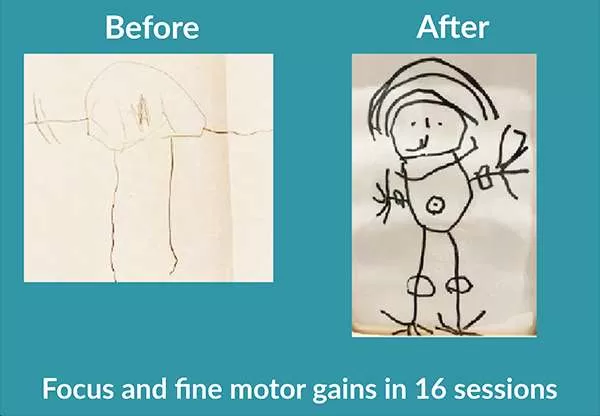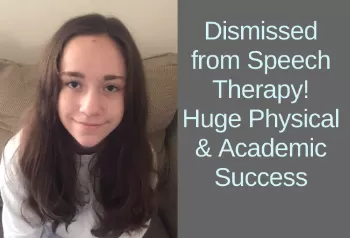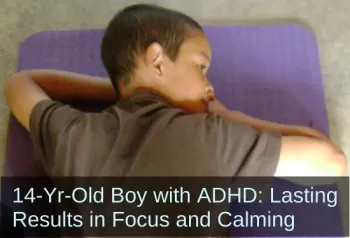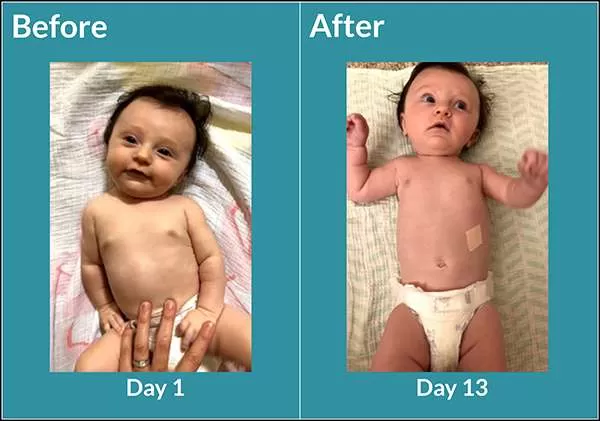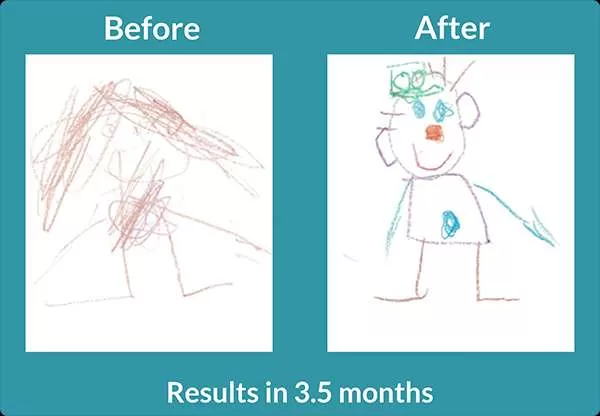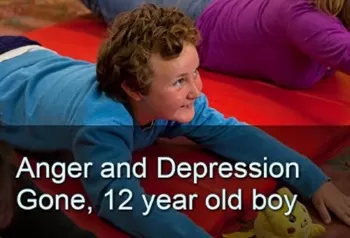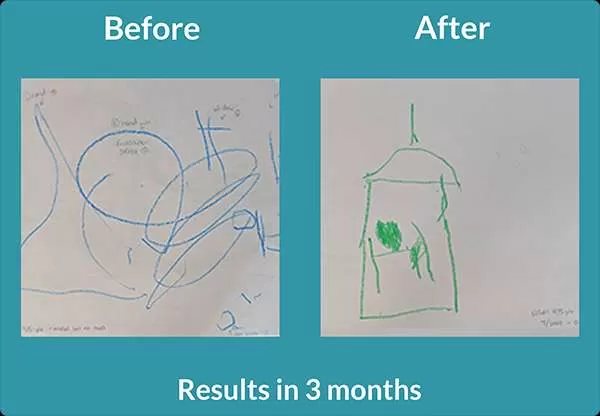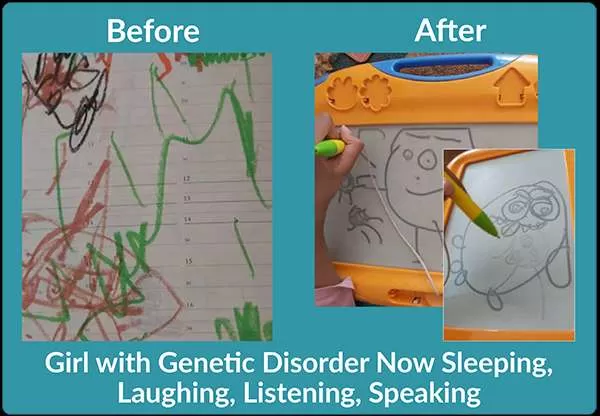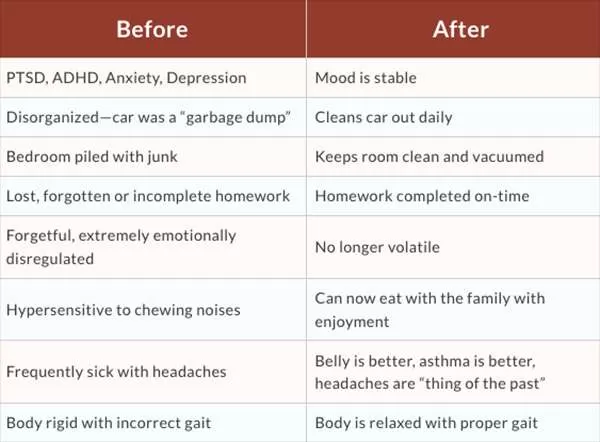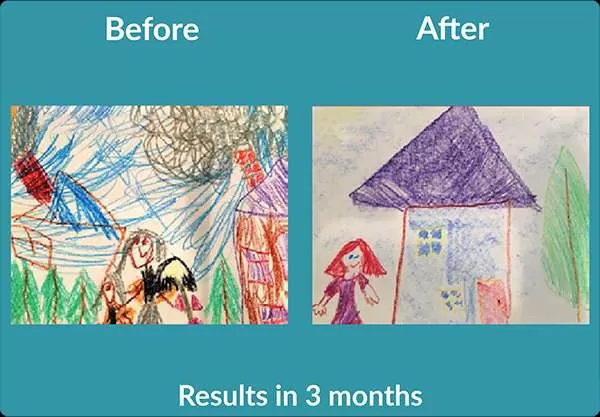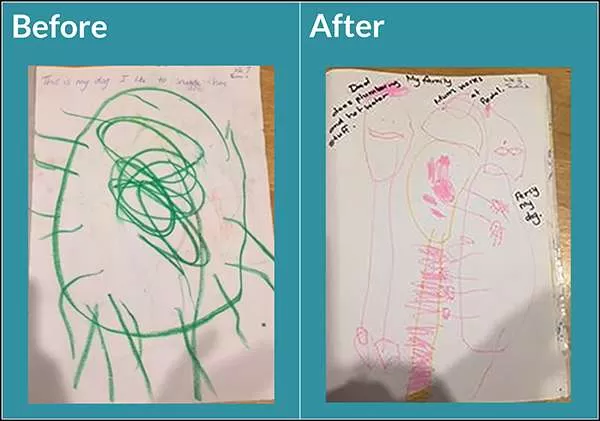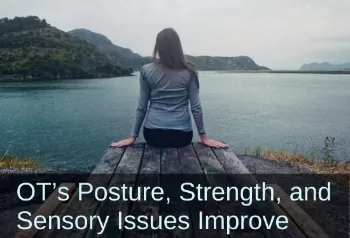Before and After Gallery
Enjoy the visuals and videos here showing remarkable results from doing the neurodevelopmental and integrative movements. All of these compelling before-and-after examples were submitted by students of the Brain and Sensory Foundations courses.
5-Year-Old Boy with ADHD Gains Improvements in Behavior, Focus, and Fine Motor Skills
This 5-year-old boy was referred to OT for several issues:
- Constant fidgeting
- Poor gross motor skills
- Fisted grip, no clear hand dominance, and avoidance of fine motor activities
Over the course of 16 sessions, his OT helped him make improvements in all these areas! For example, this Before-and-After picture shows marked improvements in the confidence and detail of his drawing. He is now developing a tri-pod grasp and using his right hand more consistently. See the full case study.
Thank you to Ingrid King, MScOT, BOT
Toddler Freed from Stimming and Sensory Challenges
The movements from the Brain and Sensory Foundations® course make a huge difference for this boy.
BEFORE: This toddler avoided sensory experiences; did not chew; did not play with toys; did a lot of flapping and stimming.
AFTER: In four months his stimming and flapping were greatly reduced; he enjoyed sand at the beach; started chewing food; used his hands to play with toys; and made eye contact with therapist. Wow!
Get the full case study.
Thank you to Yogita Bapat, Occupational Therapist
Sensory-Motor Abilities Go Hand-in-Hand with Academic Success
In this one-minute video, Jonathan shows great progress in sensory-motor ability, core strength, and reading success.
He went from a reading score of 33% to 93% on the Criterion Referenced Test after his school-based OT used the tools from the Brain and Sensory Foundations First Level course.
(Sessions were 30 mins, twice a week, Nov 2010 to April 2011, with no parent involvement)
Thank you to Steven Kane, Occupational Therapist
From IEP to All As and Bs on Report Card
This pre-teen had an IEP since the age of 3. After about 2 months of doing the rhythmic movements, she started to see changes: asking to go new places and going to the restroom by herself. Building on those successes, reflex integration movements were introduced. Soon, she was writing multiple paragraphs that were on topic, flowed well, used much more mature language, and had correct verb tense usage. She even came home with an ‘A’ on a math test, which had never happened before!
Thank you to Jennifer Davis, COTA/L
16-Year-Old Boy Greatly Improves Writing Ability and Writing Speed
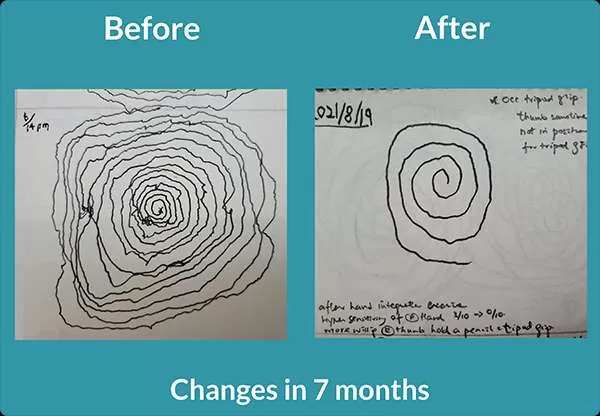
The therapist worked with this teen for approximately 7 months using the tools from the Brain and Sensory Foundations program. Note the graphic on the right: There was less shaking and better spacing. This teen developed a proper tripod grip. He became able to write with no obvious hand tremor, and he improved his writing speed from 5 words per minute to 11 words per minute. His therapist also noted that his nystagmus was much less.
Thank you to C.K., Physiotherapist
Help for Scoliosis
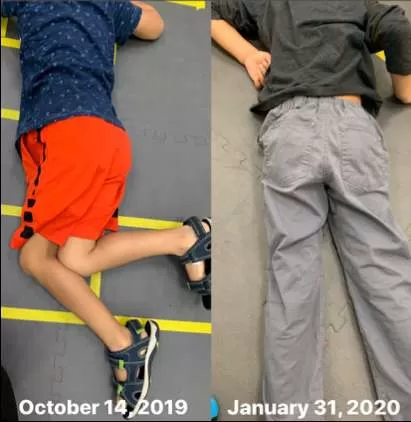 Photos by Tiffany Mabin, MS, OTR/L
Photos by Tiffany Mabin, MS, OTR/L
Children who are bedwetting past age 5 may have an retained Spinal Galant reflex that could also contribute to scoliosis. When we mature this reflex pattern with movements, we may be able to help with scoliosis and other associated challenges such as: hypersensitivity of the waist or the back; fatigue; inattention; hyperactivity; poor posture; and bedwetting. The Spinal Galant Reflex involves hip tilting on one side when the back is touched to the side of the spine.
The photos here show a child with scoliosis who could not comfortably be flat on the floor in prone. His occupational therapist used the innate rhythmic movements and Spinal Galant reflex integration from the Brain and Sensory Foundations course to help him. In 3.5 months he showed major improvements. His OT reported:
"…curvature of his spine was no longer visible, he was able to maintain prone position comfortably."
Tiffany Mabin, MS, OTR/L
In cases of scoliosis, it is important to get advice and treatment from a health practitioner.
Focus and Calm Improve Homework, Learning, and Daily Tasks for Teen
This teenager was struggling with emotional regulation and focus. Read about his tremendous positive results using movements from the Brain and Sensory Foundations First Level course.
Thank you to Laurie Bernstein OTR/L for her work on this case study.
Help for Infant Torticollis
This baby was born April 3, 2018.
Photo 1: Taken June 27, 2018
Photo 2: Taken July 9, 2018
See an additional case study from Melody Edwards, PT, showing resolution of late-stage torticollis using tools from the First Level and Second Level courses for a child whose treatment started at the age of 13 months.
Therapists and photo credit: Maggie Lloyd, OT and Cath Winfree, Massage Therapist with Melody Edwards, PT as the consulting therapist
Huge Gains in Posture and Core Strength
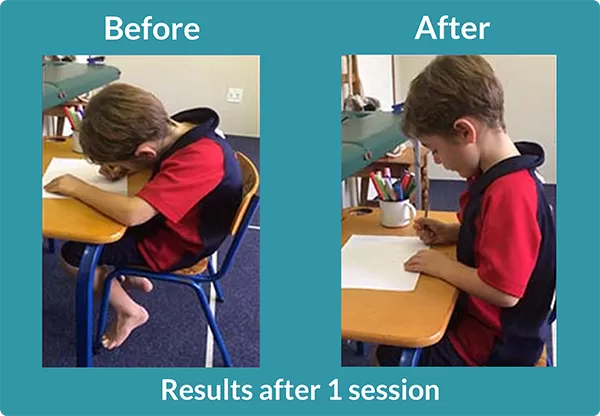
“Truly that was his posture after [the session]!”
— Lisa Muir, OT
This 6-year-old boy had inattentive behaviors, poor posture, and ocular motor concerns. Note the difference in core engagement and posture after this boy’s first 15-minute session with innate rhythmic movements.
Why it works: The innate rhythmic movements stimulate and mature the brainstem. A mature brainstem can better control muscle tone, which then improves core strength and posture.
This Before-and-After photo shows change after 15 minutes of doing innate rhythmic movements from the Brain and Sensory Foundations® training.
Thank you to Lisa Muir, Occupational Therapist
4-Year-Old Girl No Longer Needs an IEP!
BEFORE:
- This anxious girl spoke and wrote in a rushed manner; she drew in scribbles using only one color. She could not copy 2-inch letters neatly, nor could she cut a shape without switching her hands 25% of the time.
AFTER:
- Neatly copied 26/26 uppercase letters using smaller and more accurate letters of 1 inch.
- Used dominant hand consistently as well as using age-appropriate grasp.
- Colored very neatly, generally with ¼” accuracy or better and used many colors of crayons per picture. Some days she used every color of the rainbow!
- Used her dominant hand to cut with 1/8” accuracy.
Thank you to Kara Walther, Occupational Therapist
Emotions, Behaviors, and Relationships Improve for Pre-Teen Boy
Before discovering rhythmic movements and reflex integration, this boy was depressed and lethargic, had been pulled out of school due to behavior issues, and was struggling with friendships. Now, he is excited for all the possibilities in his future, is more engaged in new activities, is much less clingy, and is exhibiting more mature behavior with his friends. What a difference!
Thank you to MF, parent.
In 4 Weeks, Toddler Goes from Only Bottom-Scooting to Walking
This case study shows how a delayed 22-month-old toddler went from scooting on her bottom to walking, after only 4 weeks of innate movements!
Thank you to Melody Edwards, PT
Better Drawing, PLUS: No More Rage Episodes; Headaches Are Gone; Transitions Are Easy. Wow!
This boy was unable to perceive anything besides a single shape (e.g., square) when asked to copy a simple drawing (e.g., a house). He attempted it several times, then just scribbled in frustration, despite the fact that he could easily copy a single square. After 3 months of reflex integration (with no copying practice), he copied a recognizable house.
In addition, he struggled with extreme meltdowns and was triggered when things didn't go his way. He also did not want to be separated from his mom, and experienced headaches daily. He is no longer experiencing "rage episodes," he is more flexible with daily routines, and he is free of headaches.
Get inspired with this mother's story about her son.
Thank you to Kendra Browder, OTR/L
Girl with Genetic Disorder Draws and Writes for the First Time!
After working with rhythmic and innate reflex integration movements, this 9-year-old girl, diagnosed with PDD and Arnold Chiari type 2, drew and wrote for the first time. In addition, her eye contact is much improved, meltdowns are less frequent, and she is settling down faster at night and experiencing better sleep.
Thank you to Marie Cicilya, parent.
No More Violent Meltdowns; OT Sees Great Gains
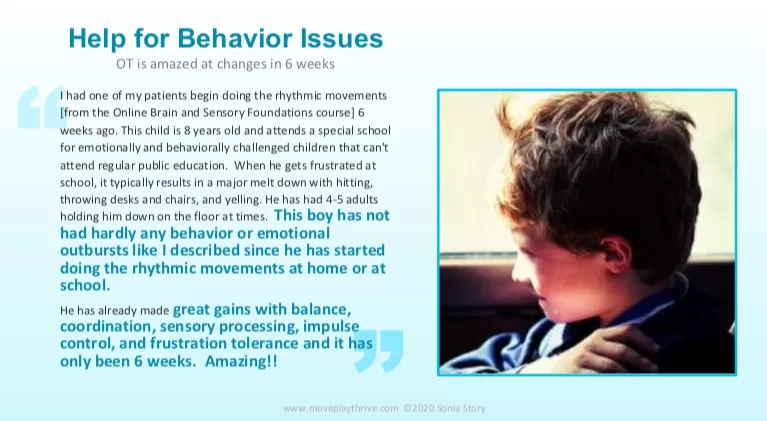
How can we help an out-of-control child to regulate? The innate rhythmic movements are relaxing, organizing, and maturing for the brain. They regulate the brainstem and help calm an excessive "fight or flight" response. This results in much better behavior along with improved sensory-motor abilities.
Quote from slide on right:
"I had one of my patients begin doing the rhythmic movements from 6 weeks ago. This child is 8 years old and attends a special school for emotionally and behaviorally challenged children that can't attend regular public education. When he gets frustrated at school it typically results in a major melt down with hitting, throwing desks and chairs, and yelling. He has had 4-5 adults holding him down on the floor at times. Since he started doing the rhythmic movements, this boy has not had hardly any behavior or emotional outbursts at home or at school. He has already made great gains with balance, coordination, sensory processing, impulse control, and frustration tolerance and it has only been 6 weeks. Amazing!"H.S., Occupational Therapist
Astounding Improvements for Young Man with PTSD, ADHD, Anxiety, Depression, and Trauma
With the help of his mother, this 20-year-old young man's life drastically improved with the innate rhythmic and reflex movements from the Brain and Sensory Foundations training.
See this young man's brief and inspiring case study and pass it on!
Thank you to M.S., Physical Therapist
Child with Autism Gains 2.7 Years in 6 Months!
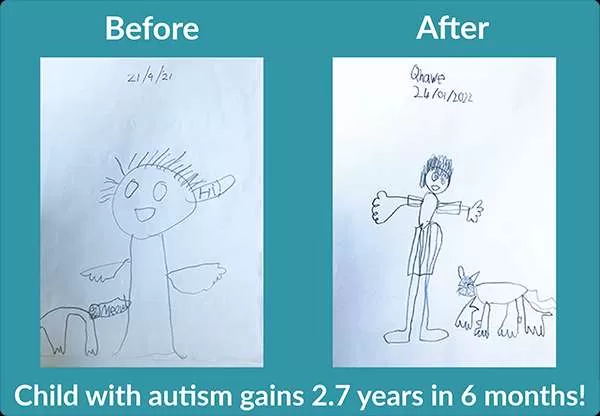 Before: Chronological age of 8.9 years with test age equivalent of 4.9 years.
Before: Chronological age of 8.9 years with test age equivalent of 4.9 years.
After: Chronological age of 9.3 years with test age equivalent of 7.6 years.
"I am always so excited to see how these movements have
such an impact.”
- Lisa Muir, BSc hons OT
Thank you to Lisa Muir, BSc hons OT
Child with Selective Mutism is Now Reading Out Loud in Class!
Nina Gallwey, a remedial education teacher, offers this dramatic example of greater sensory maturity and coherence. Before participating in a movement program, the 8½-year-old student who drew these pictures struggled with selective mutism. With regular rhythmic movement, this student’s strides amazed her speech therapist: she now reads aloud in class and joined her school’s Drama Club!
Thank you to Nina Gallwey, educator
10 minutes of Innate Rhythmic Movement Makes a Huge Difference for 5-Year-Old Boy
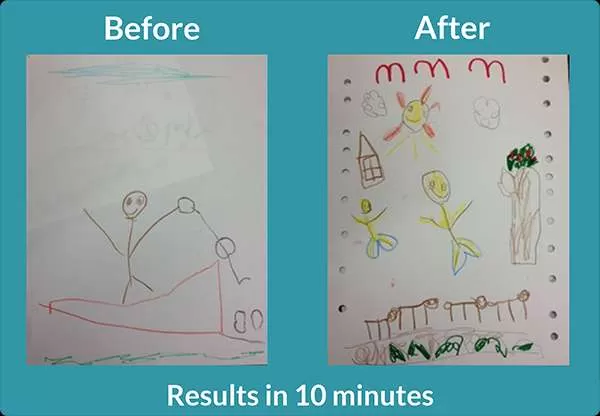
Kyle’s drawings were done just 10 minutes apart. In between, Kyle’s mother gave him innate rhythmic movements. Note the “After” drawing has greater content, detail, color, and more accurate body proportions.
Thank you to J.C., Physical Therapist
Self-Portrait Drawings Were Done 15 Minutes Apart by a 5-Year-Old Girl with Motor Planning and Coordination Challenges
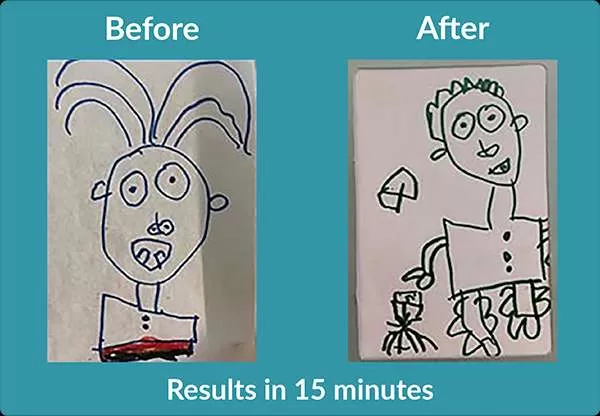
“This is a little girl who not long before this cried in my movement class, looking down at her legs, [saying], ‘they don’t work!’ ”
— Lisa Muir, BSc hons OT
These Before-and-After drawings show remarkable change after 15 minutes of doing innate rhythmic movements from the Brain and Sensory Foundations course. Notice there are no legs drawn in the “Before” drawing; in the “After” self-portrait, she includes her legs!
Thank you to Lisa Muir, BSc hons OT
Better Coordination Brings Relief from Leg Pain for this 6-Year-Old
This boy easily fatigued and complained of leg pain within 10 minutes of walking. Note in the video initially he walks with no swinging of the arms and he has poor balance. After only 3.5 weeks of innate movement, he walks with arms swinging, and shows greatly improved gait and balance; he walked for 4 hours without complaining of leg pain!
Thank you to Alisa Pittaluga, OT
Boy Establishes Hand Dominance and Gets Relief from Sensory Challenges; Self-Esteem Rises
This 4YO boy went from avoiding drawing tasks and not having a dominant hand for writing, to dramatically improved drawing skills and establishing as left-handed. He has also experienced these life-changing improvements:
- Stronger self-esteem
- Less impulsivity
- Significantly decreased proprioceptive seeking
- Reduced sensory issues
Thank you to Nevanka St Clair, Occupational Therapist
Pediatric Therapist: “Happy with Results and Very Excited about This Course”
Challenges:
- Lordosis of spine
- Weak core
- Difficulties learning to read and spell at school
- Motion sickness
- Difficulties with eye tracking and focusing on the correct position on a page
- Sensitive to light touch
- Loud constant noise caused stress
Read the full case study here.
Thank you to Nevanka St Clair, Occupational Therapist


